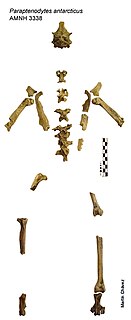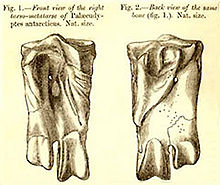
Penguins are a group of aquatic flightless birds. They live almost exclusively in the Southern Hemisphere, with only one species, the Galápagos penguin, found north of the equator. Highly adapted for life in the water, penguins have countershaded dark and white plumage and flippers for swimming. Most penguins feed on krill, fish, squid and other forms of sea life which they catch while swimming underwater. They spend roughly half of their lives on land and the other half in the sea.

Presbyornis is an extinct genus of anseriform bird. It contains two unequivocally accepted species; the well-known P. pervetus and the much lesser-known P. isoni. P. pervetus was approximately the size and shape of a goose, but with longer legs; P. isoni, known from a few bones, was much larger, more than swan-sized. Other fossils, more doubtfully assigned to this genus, are also known.
Archaeospheniscus is an extinct genus of large penguins. It currently contains three species, known from somewhat fragmentary remains. A. wimani, the smallest species, was found in Middle or Late Eocene strata of the La Meseta Formation on Seymour Island, Antarctica, whereas the other two, about the size of a modern emperor penguin, are known from bones recovered from the Late Oligocene Kokoamu Greensand Formation at Duntroon, New Zealand.

Palaeeudyptes is an extinct genus of large penguins, currently containing four accepted species. They were probably larger than almost all living penguins, with the smaller species being about the size of an emperor penguin and the largest ones having stood about 2 meters tall.

Palaeospheniscus is an extinct genus of penguins belonging to the subfamily Palaeospheniscinae. These penguins are apparently not closely related to the modern genus Spheniscus.

Paraptenodytes is an extinct genus of penguins which contains two or three species sized between a Magellanic penguin and an emperor penguin. They are known from fossil bones ranging from a partial skeleton and some additional material in the case of P. antarcticus, the type specimen for the genus, and a single humerus in the case of P. brodkorbi. The latter species is therefore often considered invalid; a recent study considers it indeed valid, but distinct enough not to belong into Paraptenodytes. The fossils were found in the Santa Cruz and Chubut Provinces of Patagonia, Argentina, in the Gaiman, Monte León and Santa Cruz Formations of Early to Middle Miocene age. Later occurrences are apparently from Late Miocene or possibly even Early Pliocene deposits.
Anthropodyptes is a poorly known monotypic genus of extinct penguin. It contains the single species Anthropodyptes gilli, known from a Middle Miocene humerus from Australia. The bone is somewhat similar to those found in members of the New Zealand genus Archaeospheniscus and thus this genus might, like them, belong to the subfamily Palaeeudyptinae.

The giant penguins, Palaeeudyptinae, are an extinct subfamily of penguins. It includes several genera of medium-sized to very large species – including Palaeeudyptes marplesi, the 1.5 meter tall Icadyptes salasi, Anthropornis nordenskjoeldi which grew 1.5 meters tall or even larger, and the massive Pachydyptes ponderosus which weighed at least as much as an adult human male.
Archaeospheniscus wimani is an extinct species of penguin. It was the smallest species of the genus Archaeospheniscus, being approximately 75 to 85 centimetres high, or about the size of a gentoo penguin. It is also the oldest known species of its genus, as its remains were found in Middle or Late Eocene strata of the La Meseta Formation on Seymour Island, Antarctica. It is known from a fair number of bones.
Archaeospheniscus lowei is the type species of the extinct penguin genus Archaeospheniscus. It stood approximately 85–115 cm high, between a modern king penguin and an emperor penguin in size. It is known from bones of a single individual and possibly some additional material such as the OM C.47.27 femur, all recovered from the Late Oligocene Kokoamu Greensand Formation at Duntroon, New Zealand.
Archaeospheniscus lopdelli was the largest species of the extinct penguin genus Archaeospheniscus, standing about 90–120 cm high, or somewhat less than the extant emperor penguin. It is only known from bones of a single individual which was found in the Late Oligocene Kokoamu Greensand Formation at Duntroon, New Zealand. Bones apparently belonging to this species are now also known from the Late Eocene La Meseta Formation on Seymour Island, Antarctica.
Marples' penguin was a large species of the extinct penguin genus Palaeeudyptes.
Palaeeudyptes gunnari is an extinct species of the extinct penguin genus Palaeeudyptes. It was a bit smaller than its congener Palaeeudyptes antarcticus of New Zealand, standing between 110 and 125 cm high, approximately the size of the emperor penguin. It is known from dozens of fossil bones from Middle or Late Eocene strata of the La Meseta Formation on Seymour Island, Antarctica. Initially, it was described as a separate genus, Eosphaeniscus. However, this was based on a single weathered and broken tarsometatarsus. Better material recovered later showed that the species belongs into the present genus.
Palaeeudyptes klekowskii, also known as the colossus penguin, was a species of the extinct penguin genus Palaeeudyptes. It was until recently thought to have been approximately the size of its congener Palaeeudyptes antarcticus, which would mean it was somewhat larger than the modern emperor penguin, but a new study shows it was in fact almost twice as tall. It is known from an extensive collection of fossil bones from the Late Eocene of the La Meseta Formation on Seymour Island, Antarctica. P. klekowskii was at first not recognized as a distinct species, and despite the coexistence of two so closely related species of similar size as Palaeeudyptes gunnari and P. klekowskii seeming somewhat improbable, the amount of fossil material suggests that the two species are indeed diagnosably different.
The extinct penguin Palaeospheniscus wimani is a member of the genus Palaeospheniscus, which belonged to the prehistoric subfamily Palaeospheniscinae. It was the largest member of its genus, being just as large as the Magellanic penguin of today.
Paraptenodytes robustus is a species of the extinct penguin genus Paraptenodytes, which is known from fossils. It was medium-sized, an estimated 70 to 80 centimetres long in life.
Paraptenodytes brodkorbi is a proposed, but possibly invalid, species of extinct penguin in the genus Paraptenodytes. The bird was probably about the size of a king penguin. Known material is limited to a single humerus, Early Miocene in age, found in the Monte León Formation near Puerto San Julián in Santa Cruz Province, Argentina. It exists as an unnumbered specimen in the collection of the Museo Argentino de Ciencias Naturales.

The Pelagornithidae, commonly called pelagornithids, pseudodontorns, bony-toothed birds, false-toothed birds or pseudotooth birds, are a prehistoric family of large seabirds. Their fossil remains have been found all over the world in rocks dating between the Early Paleocene and the Pliocene-Pleistocene boundary.

Dasornis is a genus of the prehistoric pseudotooth birds. These were probably rather close relatives of either pelicans and storks, or of waterfowl, and are here placed in the order Odontopterygiformes to account for this uncertainty.
Platydyptes is a genus of extinct penguins from the Late Oligocene to Early Miocene of New Zealand. It was created by Brian Marples in 1952 and contains three relatively large species, all of which were described from the north Otago to south Canterbury region in the South Island. The genus name Platydyptes combines the Greek platys, alluding to the shape of the humerus, with dyptes ("diver").








